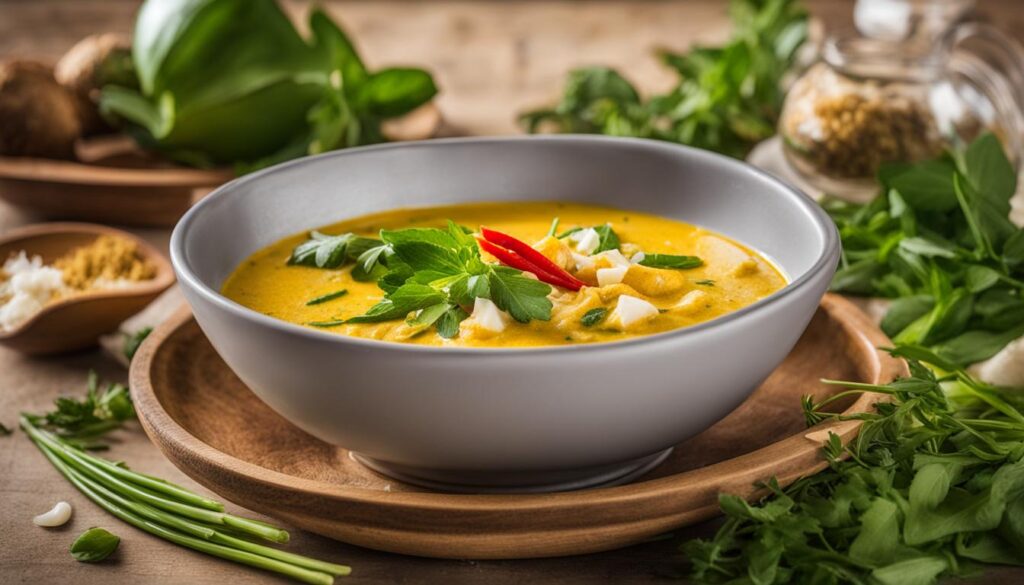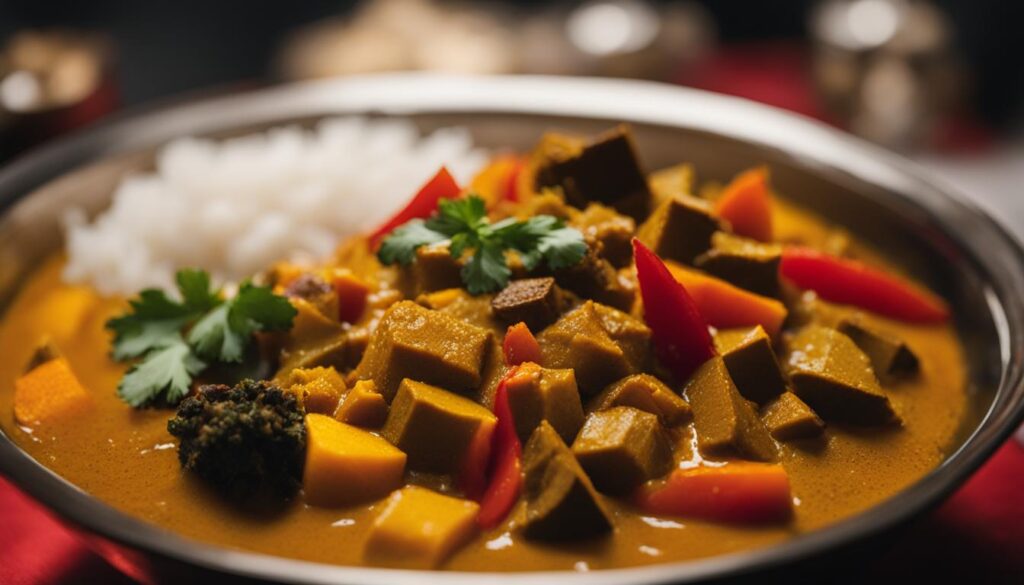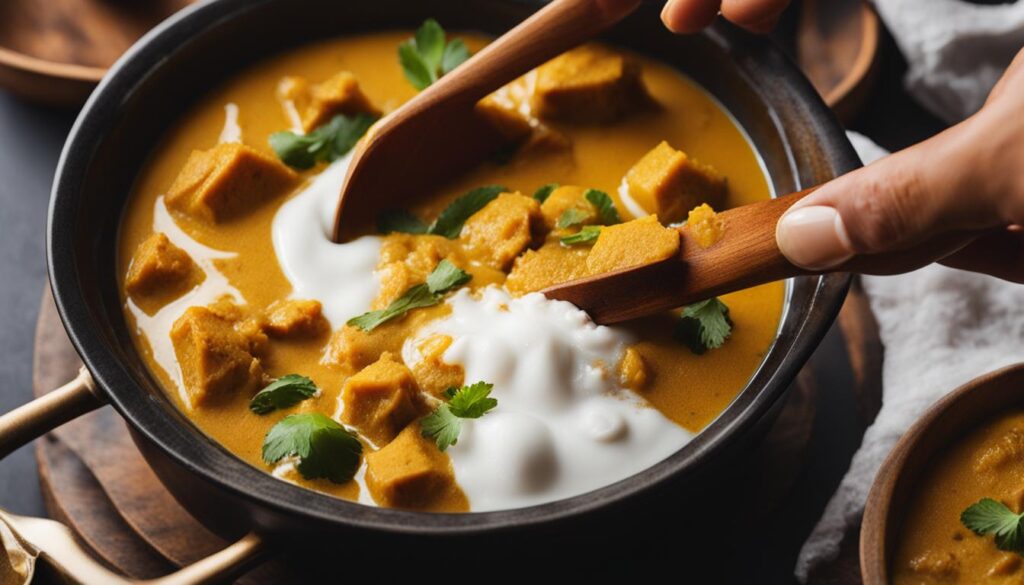Are you a fan of curry but can’t handle the heat? Too much chilli ? Don’t worry, I’ve got you covered!
There are many ways to handle spicy food without compromising the flavour.
I will share some simple techniques to help you make a curry less spicy without compromising on the delicious flavors. Whether you’re an enthusiast or just looking to experiment with new recipes, these cooking tips will come in handy. So, let’s dive in and discover how to create a milder version of your favorite curry dishes.
Key Takeaways
- Adding more vegetables can help reduce the curry spice level.
- Coconut milk or cream can be used to balance out the heat in Thai and coconut-based curries.
- Acidic ingredients like lemon juice or vinegar can cut through the spiciness and provide a tangy flavor.
- Yogurt or sour cream can help cool down the heat and add a creamy texture to the curry.
- By using starchy foods like potatoes or rice, you can counteract the spiciness and mellow out the flavors.
- Learn how to balance flavours.
Adding More Vegetables.
One of the easiest ways to knock down the spiciness is to add more vegetables.
You could try incorporating additional vegetables into the recipe. Potatoes are a popular choice as they have a mild flavor and absorb the spices well. Sweet potatoes can also be used to add a touch of sweetness and balance out the heat. Other vegetables like carrots, bell peppers, and cauliflower can also help and add texture to the dish.
Not only will adding more vegetables help lower the spice level, but it will also enhance the nutritional value of your curry. Vegetables are rich in vitamins, minerals, and fiber, making your curry a wholesome and satisfying meal. So go ahead and load up your curry with an array of colorful vegetables to create a milder and more balanced flavor profile.
| Vegetables to Add | Effect on Spice Level |
|---|---|
| Potatoes | Highly effective at reducing spiciness |
| Sweet Potatoes | Adds a touch of sweetness and dilutes heat |
| Carrots | Helps lower spice level and adds color |
| Bell Peppers | Mild flavor and balances out spices |
| Cauliflower | Reduces spiciness while adding texture |
Using Coconut Milk or Cream
One effective technique is to incorporate coconut milk or cream into the dish. Coconut milk not only adds a creamy texture but also imparts a subtle sweetness that helps balance out the heat from the spices.
To incorporate coconut milk or cream into your curry, simply add it during the cooking process. You can start by using the recommended amount in your recipe, and then adjust according to your desired spice level. The richness of the coconut milk or cream helps mellow down the spiciness while enhancing the overall flavor profile of the dish.
Whether you’re making a Thai curry or any other coconut-based curry, the addition of coconut milk or cream can make a significant difference in reducing the spice level. It provides a cooling effect to the palate, making the curry more enjoyable for those who prefer milder flavors.
To achieve the desired balance, it’s important to taste the curry as you go and add more coconut milk or cream if needed. This way, you can customize the spiciness according to your personal preference. Remember, the goal is to create a curry that caters to a wide range of tastes, so don’t hesitate to experiment and adjust the coconut milk or cream accordingly.

Table: Coconut Milk or Cream in Curries
| Curry Type | Recommended Amount of Coconut Milk or Cream |
|---|---|
| Thai Red Curry | 1 cup of coconut milk |
| Thai Green Curry | 1 cup of coconut milk |
| Indian Coconut Curry | 1/2 cup of coconut cream |
| Indonesian Rendang Curry | 1 cup of coconut milk or cream |
Using coconut milk or cream is a versatile technique that can be applied to various curry recipes. Whether you’re making a Thai curry, an Indian coconut curry, or any other curry dish, incorporating coconut milk or cream can help reduce the spiciness while adding a delightful creaminess to the overall taste.
Adding Citrus or Vinegar
When it comes to adjusting the heat in a curry adding a squeeze of lemon or lime juice, or a splash of vinegar can do wonders. These acidic ingredients not only provide a tangy flavor to the curry but also help balance out the heat. The acidity cuts through the spiciness of the spices, resulting in a more mild and enjoyable curry.
When using citrus or vinegar, it’s best to start with a small amount and gradually increase if needed. Remember to taste the curry as you go to ensure the desired level of spiciness is achieved. The goal is to strike the right balance between heat and acidity for a perfectly adjusted curry.
When using citrus or vinegar, it’s best to start with a small amount and gradually increase if needed. Remember to taste the curry as you go to ensure the desired level of spiciness is achieved. The goal is to strike the right balance between heat and acidity for a perfectly adjusted curry.
| Ingredient | Effect |
|---|---|
| Lemon Juice | Cuts through spiciness, adds a refreshing tang |
| Lime Juice | Brightens the flavor, balances the heat |
| Vinegar | Mellows out the spiciness, adds depth of flavor |
Using Yogurt or Sour Cream
When it comes to reducing the spiciness of a curry, yogurt or sour cream can be your secret weapons. These creamy and tangy ingredients not only add a delightful texture to the dish but also help to cool down the heat. Whether you’re making an Indian-style curry or experimenting with different spice blends, incorporating yogurt or sour cream can make a noticeable difference in the overall spiciness of the dish.
Adding a dollop of yogurt or sour cream to your curry not only helps to balance the flavors but also provides a soothing and creamy element. The dairy-based products work by coating your taste buds, counteracting the heat and providing a refreshing contrast. The mildness of yogurt or sour cream tones down the spiciness, ensuring that even those who prefer a milder curry can enjoy the dish without overpowering heat.
To incorporate yogurt or sour cream into your curry, simply add a spoonful or two towards the end of the cooking process. Gently stir the curry to distribute the creamy goodness throughout, allowing it to blend with the other flavors. Keep in mind that if you’re adding yogurt to a hot curry, it’s important to temper the yogurt first. This can be done by slowly adding a little curry sauce to the yogurt, stirring constantly, before adding the mixture to the rest of the curry. By doing so, you’ll prevent the yogurt from curdling and ensure a smooth and velvety finish.
Yogurt vs. Sour Cream: Which to Choose?
When deciding between yogurt and sour cream, consider the flavor and texture you desire in your curry. Yogurt tends to have a tangier taste and a lighter texture, while sour cream is milder and creamier. If you’re looking to add a subtle tanginess to your curry, opt for yogurt. On the other hand, if you prefer a richer and creamier consistency, sour cream will be your go-to choice. Both options will effectively reduce the spiciness of your curry and add a delightful twist to the overall flavor profile.
Adding Sweetness
When it comes to reducing the heat in a tomato-based curry, adding a pinch of sugar can do wonders. This simple trick helps to counteract the spiciness and adds a touch of sweetness to the dish. However, it’s important to approach this with caution and taste the curry as you go, ensuring that the sweetness doesn’t overpower the other flavors.
Another way to incorporate sweetness into a tomato-based curry is by adding a spoonful of ketchup. The tangy and slightly sweet flavor of the ketchup can help balance out the spices and reduce the heat in the dish. Just like with sugar, it’s important to taste and adjust the amount of ketchup according to your preferences.
By adding sweetness to a tomato-based curry, you can create a harmonious balance of flavors, where the spiciness is tempered by the subtle sweetness. This technique allows you to enjoy the rich flavors of the curry without being overwhelmed by the heat. Experiment with different amounts of sugar or ketchup until you find the perfect level of sweetness that suits your taste buds.
Using Starchy Foods
When it comes to reducing the spiciness of a curry, adding starchy foods like potatoes or rice can be a game-changer. These ingredients have a natural ability to counteract the heat and create a milder flavor profile. The starch in potatoes and rice helps absorb some of the spice, making the curry more enjoyable for those who prefer a less spicy dish.
To incorporate potatoes into your curry, simply peel, chop, and add them to the simmering pot. The potatoes will absorb the excess heat, making the curry less intense. Additionally, the soft texture of the cooked potatoes adds a delightful contrast to the curry’s overall mouthfeel. Rice, on the other hand, can be served as a side dish alongside the curry. The mildness of rice helps balance out the spices in the curry, providing a satisfying and well-rounded meal.
Another option is to use starchy vegetables like sweet potatoes or butternut squash. These vegetables not only add a pleasant sweetness to the dish but also help tame the spiciness. Their creamy texture and subtle flavors complement the spices in the curry, creating a harmonious balance. Experiment with different starchy foods to find the ones that work best for your curry and taste preferences.
| Starchy Foods to Counteract Heat in Curry |
|---|
| Potatoes |
| Rice |
| Sweet Potatoes |
| Butternut Squash |
By incorporating starchy foods like potatoes and rice into your curry, you can effectively reduce the spiciness and create a milder, more enjoyable dish. These ingredients not only absorb the excess heat but also add texture and balance to the overall flavor profile. So next time you’re making a curry and want to tone down the spice, reach for some potatoes or serve it with a side of rice. Your taste buds will thank you!
Balancing with Acidity
When it comes to making a curry less spicy, balancing the flavors with acidity can be a game-changer. The tangy notes of lemon juice, lime juice, or vinegar can help cut through the spiciness and bring a harmonious balance to your dish.
By adding a small amount of acidity, you can reduce the heat without compromising the overall taste. The acidity works by counteracting the spiciness, creating a more pleasant and enjoyable flavor profile.
Whether you choose to squeeze fresh lemon or lime juice over your curry or add a splash of vinegar, the result will be a curry with a perfect spice level that caters to your preference. Be sure to taste the curry as you go to find the right level of acidity that complements the other flavors.
So next time you’re looking to make a curry less spicy, don’t forget to reach for the citrus fruits or vinegar in your pantry. Embrace the power of balancing with acidity to create a curry that satisfies your taste buds.

Cooling Techniques for Specific Curry Dishes
When it comes to specific curry dishes, different techniques can be used to reduce spiciness and create a more enjoyable dining experience. Let’s explore some cooling techniques for Thai curries, coconut-based curries, and tomato-based dishes.
Thai Curries:
Thai curries are known for their bold flavors and spicy kick. To cool down the heat, adding more coconut milk or cream can be highly effective. The creamy texture and subtle sweetness of coconut milk help balance out the spiciness, creating a harmonious blend of flavors. Whether it’s a red, green, or yellow Thai curry, increasing the amount of coconut milk or cream will provide a milder taste profile.
Coconut-Based Curries:
Coconut-based curries, such as Malaysian rendang or Indian coconut chicken curry, also benefit from the addition of coconut milk to reduce spiciness. The rich and creamy nature of coconut milk helps tone down the heat while enhancing the overall flavor. Adjusting the amount of coconut milk to suit your preference will ensure a satisfying and less spicy curry experience.
Tomato-Based Dishes:
Tomato-based curries, like the popular Indian butter chicken or tomato and lentil curry, can be made less spicy by adding a touch of sweetness or acidity. A pinch of sugar or a spoonful of ketchup can counteract the spiciness and introduce a subtle sweetness to the dish. Alternatively, a squeeze of lemon or lime juice can provide a tangy flavor that balances out the heat. Experiment with these ingredients to find the perfect balance of flavors in your tomato-based curries.
By employing these cooling techniques specific to various curry dishes, you can tailor the spiciness to your preference and enjoy a delicious meal without overwhelming heat. Remember to adjust the quantities of ingredients according to your taste and savor the delightful flavors of these aromatic dishes.
| Curry Dish | Recommended Cooling Technique |
|---|---|
| Thai curries | Add more coconut milk or cream |
| Coconut-based curries | Increase coconut milk |
| Tomato-based dishes | Add a pinch of sugar or citrus juice |
Try this Mild Curry Recipe
Looking for a delicious Indian dish that’s packed with flavor but not too spicy? This mild curry recipe is the perfect choice. With a delicate balance of aromatic spices and creamy textures, it’s sure to be a hit at your next meal. Let’s dive into the recipe and learn how to create a less spicy curry that perfectly complements any meal.
Ingredients:
- 500g boneless chicken, cut into bite-sized pieces
- 2 tablespoons vegetable oil
- 1 large onion, finely chopped
- 3 garlic cloves, minced
- 1-inch piece of ginger, grated
- 2 teaspoons curry powder
- 1 teaspoon ground cumin
- 1 teaspoon ground coriander
- 1/2 teaspoon turmeric powder
- 1/4 teaspoon cayenne pepper (adjust according to your spice preference)
- 400ml canned diced tomatoes
- 200ml coconut milk
- Salt to taste
- Fresh cilantro, chopped, for garnish
Instructions:
- In a large pan, heat the vegetable oil over medium heat. Add the chopped onion and sauté until golden brown.
- Add the minced garlic and grated ginger to the pan, and sauté for another minute until fragrant.
- Next, add the curry powder, ground cumin, ground coriander, turmeric powder, and cayenne pepper to the pan. Stir well to coat the onions and spices evenly.
- Add the diced chicken to the pan and cook until it’s no longer pink, about 5-7 minutes.
- Pour in the canned diced tomatoes and coconut milk, and season with salt to taste. Give it a good stir, then reduce the heat to low and let the curry simmer for 20-25 minutes, allowing the flavors to meld together.
- Once the curry has thickened slightly and the chicken is cooked through, remove it from the heat.
- Garnish with freshly chopped cilantro, and serve your mild curry with steamed rice or naan bread.
This mild curry recipe is the perfect balance of flavors, with a hint of spice that won’t overwhelm your taste buds. It’s a versatile dish that can be customized to your liking by adjusting the amount of cayenne pepper or adding additional vegetables. Enjoy the rich and creamy texture of this curry, and savor every bite of this delicious Indian dish.
Conclusion
So there you have it, some handy tips and tricks on how to make a curry less spicy. By following these techniques, you can reduce the heat without compromising the overall taste of the dish. Whether you prefer a milder curry or want to accommodate those who are sensitive to spice, these methods are sure to help you achieve the perfect balance.
Experiment with adding more vegetables like potatoes and sweet potatoes to dilute the spice level, or try incorporating coconut milk or cream for a creamy and mild curry. Adding citrus or vinegar can provide a tangy flavor while balancing out the heat, and yogurt or sour cream can cool down the spiciness and add a creamy texture. Don’t forget to play with sweetness by using a pinch of sugar or a spoonful of ketchup in tomato-based curries.
Remember, making a curry less spicy doesn’t mean sacrificing flavor. With these tips and tricks, you can enjoy a milder curry that still packs a punch in terms of taste. So go ahead, get creative in the kitchen, and enjoy the wonderful world of curry with the perfect level of spice for you!
FAQ
How can I make a curry less spicy?
There are several techniques you can try. Adding more vegetables to the curry can help dilute the spice. Using coconut milk or cream can also reduce the spiciness. Adding citrus or vinegar provides a tangy flavor that balances the heat. Yogurt or sour cream can cool down the curry. Adding a pinch of sugar or ketchup can counteract the spiciness. Starchy foods like potatoes or rice can absorb heat. Acidic ingredients like lemon juice, lime juice, or vinegar can cut through the spiciness. Different curry dishes may require different techniques to reduce spiciness.
What vegetables can I add to make a curry less spicy?
Starchy vegetables like potatoes and sweet potatoes work well in reducing the heat of a curry. By adding more vegetables, the overall spice level of the curry will be diluted.
How does coconut milk or cream help reduce the spiciness of a curry?
Coconut milk or cream adds a creamy texture and subtle sweetness to the curry, which can balance out the heat of the spices.
How can I use citrus or vinegar to make a curry less spicy?
Adding a squeeze of lemon or lime juice, or a splash of vinegar to the curry can provide acidity that balances out the heat and adds a tangy flavor.
How can yogurt or sour cream help reduce the spiciness of a curry?
Adding a dollop of yogurt or sour cream to Indian-style curries can cool down the spice and provide a creamy texture.
What can I add to a tomato-based curry to make it less spicy?
Adding a pinch of sugar or a spoonful of ketchup to a tomato-based curry can counteract the spiciness and add a touch of sweetness. Be sure to taste the curry as you go to avoid overpowering the other flavors.
How can starchy foods help reduce the spiciness of a curry?
Adding starchy foods like potatoes or rice to a curry can help absorb some of the heat and counteract the spiciness. Serving the curry with a side of potatoes or rice can also provide a milder flavor to balance out the spices.
How does acidity help reduce the spiciness of a curry?
Acidic ingredients like lemon juice, lime juice, or vinegar can help cut through the spiciness of a curry and balance out the flavors. Adding a small amount of acidity to t

